Press Releases
Euroseas Ltd. Reports Results for the Year and Quarter Ended December 31, 2010
Maroussi, Athens, Greece - Euroseas Ltd. (NASDAQ: ESEA), an owner and operator of drybulk and container carrier vessels and provider of seaborne transportation for drybulk and containerized cargoes, announced today its results for the quarter and year ended December 31, 2010.
Fourth Quarter 2010 Highlights:
· Net loss of $0.9 million or $0.03 loss per share basic and diluted on total net revenues of $12.8 million. Excluding the effect of unrealized gain and realized loss on derivatives and unrealized loss on trading securities and amortization of the fair value of charters acquired, the net loss for the period would have been $3.9 million, or $0.12 loss per share basic and diluted.
· Adjusted EBITDA was $1.0 million. Please refer to a subsequent section of the Press Release for a reconciliation of adjusted EBITDA to net income.
· An average of 16.00 vessels were owned and operated during the fourth quarter of 2010 earning an average time charter equivalent rate of $10,091 per day. M/V Eleni P was released in December 2010 after seven months of captivity after being hijacked in May of 2010.
· Declared a quarterly dividend of $0.06 per share for the fourth quarter of 2010 payable on March 11, 2011 to shareholders of record on March 1, 2011. This is the 22nd consecutive quarterly dividend declared.
Full Year 2010 Highlights:
· Net loss of $6.6 million or $0.21 loss per share basic and diluted on total net revenues of $52.5 million. Excluding the effect of unrealized gain and realized loss on derivatives and unrealized loss on trading securities and amortization of the fair value of charters acquired, the net loss for the period would have been $4.3 million, or $0.14 loss per share basic and diluted.
· Adjusted EBITDA was $14.4 million. Please refer to a subsequent section of the Press Release for a reconciliation of adjusted EBITDA to net income.
· An average of 15.5 vessels were owned and operated during 2010 earning an average time charter equivalent rate of $11,201 per day.
· Declared four quarterly dividends for a total of $0.23 per share during 2010.
· Completed a joint venture with private equity firms under which we purchased 6 vessels in 2010 investing almost half of the committed capital of $175 million. Euroseas has committed $25 million to the venture.
Aristides Pittas, Chairman and CEO of Euroseas commented: "2010 was a significant year for Euroseas in many respects. It was a difficult year as our containership fleet had to go through a period of low earnings as a result of charters we had to enter into during the bottom of the market in 2009 and the first half of 2010. Two of our containerships that had been laid up in 2009 were only reactivated during the second half of the year when the container market started to recover. On the other hand, it was a pivotal year as we took advantage of the low containership prices and acquired one vessel directly, and 6 more vessels via Euromar, our joint venture with two private firms which we concluded in the first quarter of 2010. On our own and via Euromar, we have more than $100m of cash which we plan to invest as attractive opportunities and accretive projects are identified.
Looking into 2011 and beyond, we expect significant contribution to our earnings from our containership fleet and investment in Euromar as our containership charters are being rolled over from the existing lower levels to rates reflecting the currently rising market rates. At the same time, our drybulk fleet is fully covered for 2011 and a good part of 2012, insulating us from the widely anticipated weakness in that sector. Thus, I would like to suggest that investors look at us as a company with a base revenue secured from our drybulk fleet and with significant exposure to the recovering containership sector, especially, the geared segment below 3000teu. We believe that in addition to the overall containership market recovery, the below 3000teu segment will benefit from the rapidly developing trades involving the entire developing world.
Reaffirming our positive prospects, our Board decided to maintain our quarterly dividend of $0.06 per share which represents an annual yield of about 6.25% on the basis of our stock price on February 15, 2011."
Tasos Aslidis, Chief Financial Officer of Euroseas commented: "The results of the fourth quarter of 2010 reflect primarily the high number of our vessels that were drydocked during the quarter. In several cases, we chose to accelerate the drydocking, especially of containerships, in order to increase our flexibility of chartering our fleet in a market that it is anticipated to continue improving after the year-end seasonal slowdown. As in previous periods of 2010, our financial results for the quarter were negatively influenced by realized losses in FFAs and interest rate swap contracts and positively affected by net unrealized gains on our overall derivative positions. We have now settled all our FFA contracts that were initiated in the first half of 2009 to provide us protection against the possibility of a drybulk market collapse. For 2011, we only have a pair of contracts for a panamax vessel equivalent that protects us if rates fall below $16,500/day and caps our upside at $23,500/day; with spot rates for the index vessel around $13,500/day, this contract is currently providing us with the desired coverage.
Total daily vessel operating expenses, including management fees, general and administrative expenses but excluding drydocking costs, reflect an increase of about 5.5% during the fourth quarter of 2010 compared to the same quarter of last year which is primarily due to the fact that all of our vessels are now operating as compared to having 3 vessels laid-up during the fourth quarter of 2009; and, a decrease of about 4.6% for the full year ended December 31, 2010 over 2009. As always, we want to emphasize that cost control remains a key component of our strategy and we believe that our 2010 total daily average cost per vessel of $5,191 clearly reflects our success in this respect.
During the fourth quarter of 2010, we drew loans totaling $28.5 million against two of our unencumbered vessels in order to enhance our liquidity and continue our fleet renewal and expansion program. As of December 31, 2010, our outstanding debt was $88.39 million versus restricted and unrestricted cash of about $40.1 million. Even after the new loans, we estimate that our debt-to-market value of fleet ratio is around 40%, still a quite conservative level. As of the same date, our scheduled debt repayments over the next 12 months amounted to about $13.5 million, a number low enough to provide us with significant operational cash flow comfort. All our debt covenants were satisfied as of December 31, 2010."
Fourth Quarter 2010 Results:
For the fourth quarter of 2010, the Company reported total net revenues of $12.8 million representing a 22.3% decrease over total net revenues of $16.5 million during the fourth quarter of 2009. The Company reported net loss for the period of $0.9 million as compared to a net loss of $16.3 million for the fourth quarter of 2009. The results for the fourth quarter of 2010 include a $4.0 million net unrealized gain on derivatives and trading securities and a $1.6 million net realized loss on derivatives as compared to $5.1 million net unrealized loss on derivatives and trading securities and $4.8 million realized loss on derivatives for the same period of 2009.
Depreciation expenses for the fourth quarter of 2010 were $4.6 million compared to $4.7 million during the same period of 2009. On average, 16.00 vessels were owned and operated during the fourth quarter of 2010 earning an average time charter equivalent rate of $10,091 per day compared to 16.68 vessels in the same period of 2009 earning on average $13,892 per day.
Adjusted EBITDA for the fourth quarter of 2010 was $1.0 million, a 79.5% decrease from $4.9 million achieved during the fourth quarter of 2009. Please see below for Adjusted EBITDA reconciliation to net income / loss and cash flow provided by operating activities.
Basic and diluted losses per share for the fourth quarter of 2010 were $0.03, calculated on 30,968,108 basic and diluted weighted average number of shares outstanding, compared to basic and diluted losses per share of $0.53 for the fourth quarter of 2009, calculated on 30,813,960 weighted average number of shares outstanding, basic and diluted.
Excluding the effect on the losses for the quarter of the unrealized gain on derivatives and the realized loss on derivatives, unrealized loss on trading securities and amortization of the fair value of time charter contracts acquired, the loss per share for the quarter ended December 31, 2010 would have been $0.12 per share, basic and diluted, compared to earnings per share of $0.00 for the quarter ended December 31, 2009. Usually, security analysts do not include the above items in their published estimates of earnings per share.
Full Year 2010 Results:
For the full year of 2010, the Company reported total net revenues of $52.5 million representing a 17.7% decrease over total net revenues of $63.8 million during the full year of 2009. The Company reported a net loss for the period of $6.6 million as compared to net loss of $15.6 million for the full year of 2009. The results for 2010 include a $8.1 million net unrealized gain on derivatives and trading securities and a $12.4 million net realized loss on derivatives as compared to $7.6 million net unrealized loss on derivatives and trading securities and $8.2 million net realized loss on derivatives for the same period of 2009.
Depreciation expenses for year 2010 were $18.0 million compared to $19.1 million during the same period of 2009. On average, 15.5 vessels were owned and operated during 2010 earning an average time charter equivalent rate of $11,201 per day compared to 16.3 vessels in the same period of 2009 earning on average $13,698 per day. Two of the Company?s vessels that were laid up during the entire first half of 2010, were reactivated during the fourth quarter of the year.
Adjusted EBITDA for year 2010 was $14.4 million, a 41.9% decrease from $24.9 million achieved during 2009. Please see below for Adjusted EBITDA reconciliation to net income/loss and cash flow provided by operating activities.
Basic and diluted loss per share for year 2010 was $0.21, calculated on 30,900,122 weighted average number of shares outstanding, compared to basic and diluted loss per share of $0.51 basic and diluted per share for the year 2009, calculated on 30,648,991 basic and diluted weighted average number of shares outstanding.
Excluding the effect on the earnings of the unrealized gain on derivatives, realized loss on derivatives, unrealized loss on trading securities and amortization of the fair value of time charter contracts acquired, the net loss per share for the year ended December 31, 2010 would have been $0.14 per share compared to earnings of $0.18 per share, basic and diluted, for the same period in 2009. Usually, security analysts do not include the above items in their published estimates of earnings per share.
Fleet Profile:
The Euroseas Ltd. fleet profile is as follows:
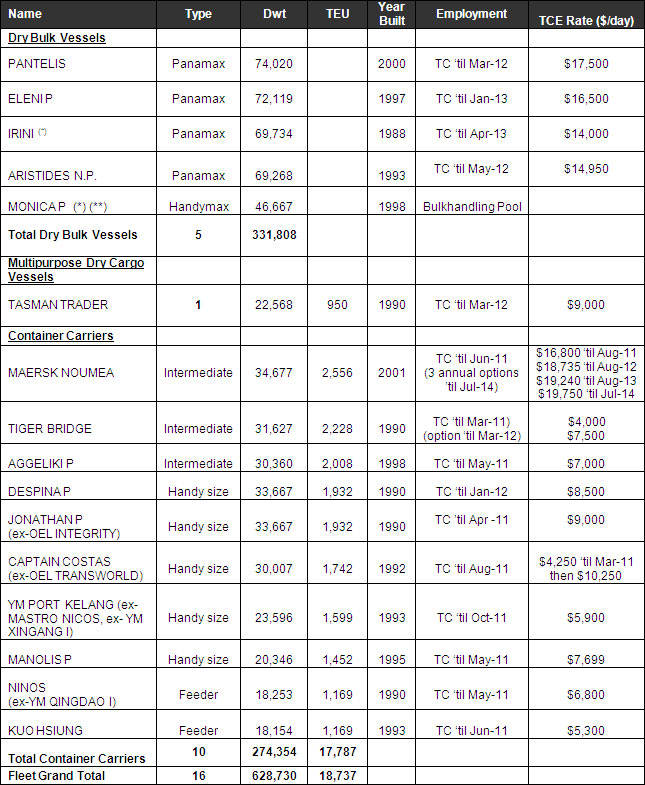
(*) "Monica P" is employed in the Bulkhandling spot pool that is also managed by Klaveness.
(**) The company has concluded a Forward Freight Agreement(FFA) option contract on the panamax index for calendar 2011 for a modern panamax. Such a contract serves as an approximate hedge to one of our panamax vessels for 2011 effectively locking in a rate between $16,500 and $23,500.
(***) Charter duration are meant to be the earliest redelivery dates. Generally, charterers have a range of 15 days to 3 of months to redeliver the vessels depending on the length of the charter.
Summary Fleet Data:
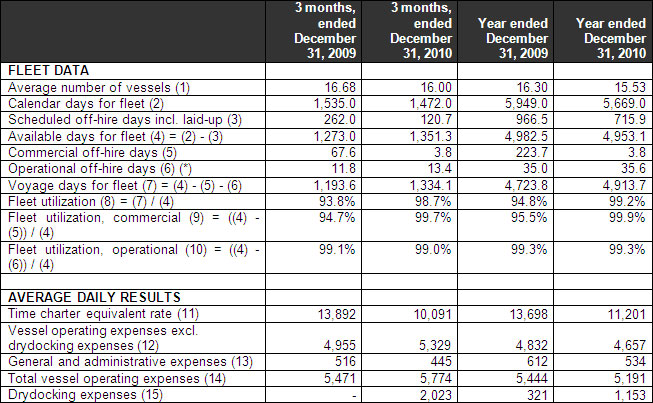
(1) Average number of vessels is the number of vessels that constituted our fleet for the relevant period, as measured by the sum of the number of calendar days each vessel was a part of our fleet during the period divided by the number of calendar days in that period.
(2) Calendar days. We define calendar days as the total number of days in a period during which each vessel in our fleet was in our possession including off-hire days associated with major repairs, drydockings or special or intermediate surveys or days of vessels in lay-up. Calendar days are an indicator of the size of our fleet over a period and affect both the amount of revenues and the amount of expenses that we record during that period.
(3) The scheduled off-hire days including vessels laid-up are days associated with scheduled repairs, drydockings or special or intermediate surveys or days of vessels in lay-up. The shipping industry uses available days to measure the number of days in a period during which vessels were available to generate revenues.
(4) Available days. We define available days as the total number of days in a period during which each vessel in our fleet was in our possession net of scheduled off-hire days including days of vessels laid-up.
(5) Commercial off-hire days. We define commercial off-hire days as days waiting to find employment.
(6) Operational off-hire days. We define operational off-hire days as days associated with unscheduled repairs or other off-hire time related to the operation of the vessels.
(7) Voyage days. We define voyage days as the total number of days in a period during which each vessel in our fleet was in our possession net of commercial and operational off-hire days. The shipping industry uses voyage days to measure the number of days in a period during which vessels actually generate revenues. In 2010, we treated as operational the days of one of our vessels while she was hijacked as during that period the vessel original charter was insured and, in addition, the vessel did receive hire from insurance for the entire period of hijacking.
(8) Fleet utilization. We calculate fleet utilization by dividing the number of our voyage days during a period by the number of our available days during that period. The shipping industry uses fleet utilization to measure a company?s efficiency in finding suitable employment for its vessels and minimizing the amount of days that its vessels are off-hire for reasons such as unscheduled repairs or days waiting to find employment.
(9) Fleet utilization, commercial. We calculate commercial fleet utilization by dividing our available days net of commercial off-hire days during a period by our available days during that period.
(10) Fleet utilization, operational. We calculate operational fleet utilization by dividing our available net of operational off-hire days during a period by our available days during that period.
(11) Time charter equivalent, or TCE, is a measure of the average daily revenue performance of a vessel on a per voyage basis. Our method of calculating TCE is consistent with industry standards and is determined by dividing revenue generated from voyage charters (including for that matter any insurance proceeds from loss of hire insurance) net of voyage expenses by voyage days for the relevant time period. Voyage expenses primarily consist of port, canal and fuel costs that are unique to a particular voyage, which would otherwise be paid by the charterer under a time charter contract, as well as commissions. TCE is a standard shipping industry performance measure used primarily to compare period-to-period changes in a shipping company?s performance despite changes in the mix of charter types (i.e., spot voyage charters, time charters and bareboat charters) under which the vessels may be employed between the periods.
(12) Daily vessel operating expenses, which includes crew costs, provisions, deck and engine stores, lubricating oil, insurance, maintenance and repairs and management fees are calculated by dividing vessel operating expenses by fleet calendar days for the relevant time period. Drydocking expenses are reported separately.
(13) Daily general and administrative expense is calculated by dividing general and administrative expense by fleet calendar days for the relevant time period.
(14) Total vessel operating expenses, or TVOE, is a measure of our total expenses associated with operating our vessels. TVOE is the sum of vessel operating expenses excluding drydocking expenses and general and administrative expenses. Daily TVOE is calculated by dividing TVOE by fleet calendar days for the relevant time period.
(15) Drydocking expenses, which include expenses during drydockings that would been capitalized and amortized under the deferral method divided by the fleet calendar days for the relevant period. Drydocking expenses could vary substantially from period to period depending on how many vessels underwent drydocking during the period.
Conference Call and Webcast:
Later today, Tuesday, February 22, 2011 at 8:00 a.m. EST, the company's management will host a conference call to discuss the results.
Conference Call details:
Participants should dial into the call 10 minutes before the scheduled time using the following numbers: 1 866 819 7111 (from the US), 0800 953 0329 (from the UK) or +44 (0)1452 542 301 (international standard dial in). Please quote "Euroseas".
A recording of the conference call will be available until March 1, 2011 by dialing 1 866 247 4222 (from the US), 0800 953 1533 (from the UK) or +44 (0)1452 550 000 (international standard dial in). Access Code: 6973591#
Audio webcast ? Slides Presentation:
There will be a live and then archived audio webcast of the conference call, via the internet through the Euroseas website (www.euroseas.gr). Participants to the live webcast should register on the website approximately 10 minutes prior to the start of the webcast. A slide presentation on the fourth quarter and full year 2010 results in PDF format will also be available 30 minutes prior to the conference call and webcast accessible on the company?s website (www.euroseas.gr) on the webcast page. Participants to the webcast can download the PDF presentation.
Consolidated Condensed Statements of Operations
(All amounts expressed in U.S. Dollars ? except share amounts)
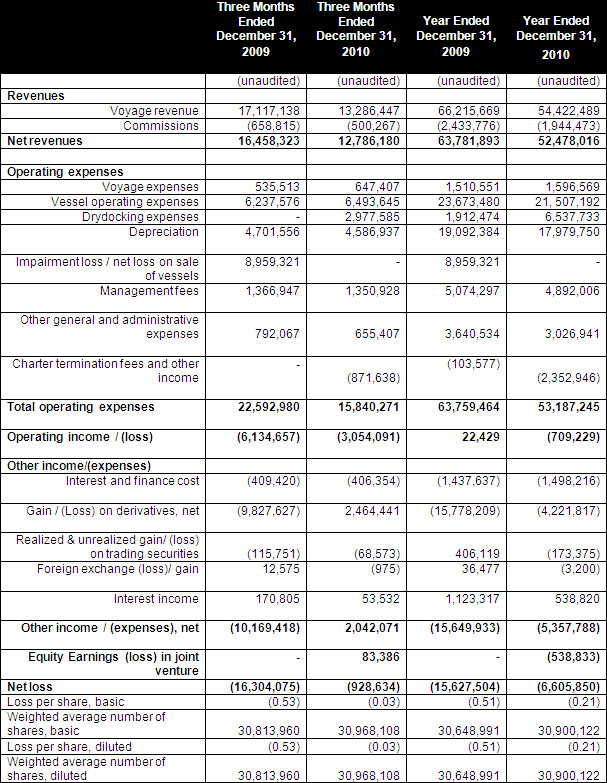
Consolidated Condensed Balance Sheets
(All amounts expressed in U.S. Dollars - except share amounts)
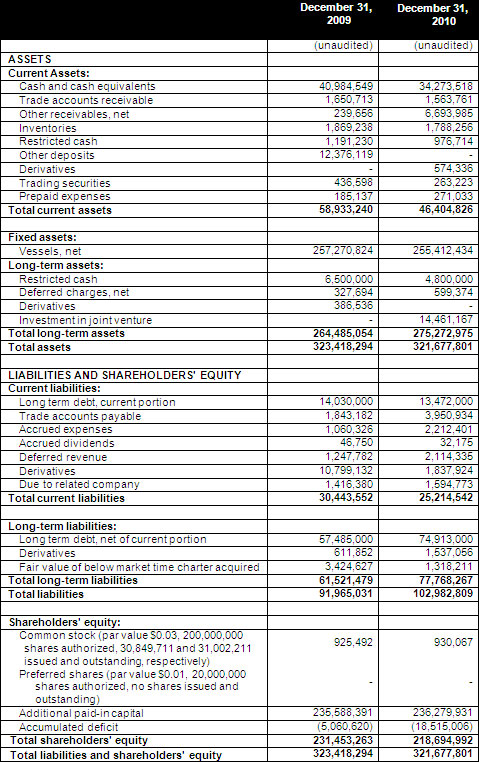
Consolidated Condensed Statements of Cash Flows
(All amounts expressed in U.S. Dollars)
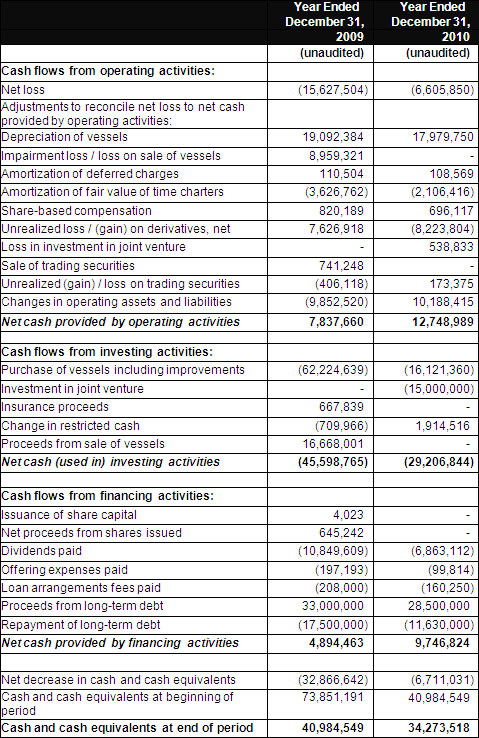
Reconciliation of Adjusted EBITDA to
Net Loss and Cash Flow Provided By Operating Activities
(All amounts expressed in U.S. Dollars)
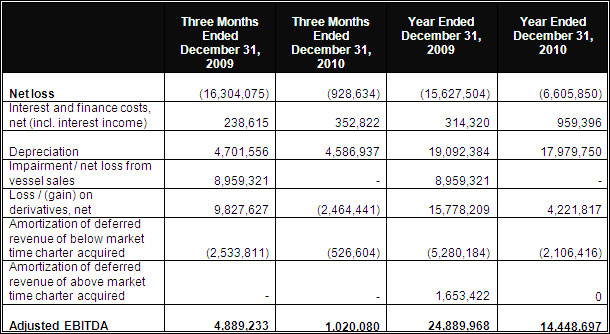
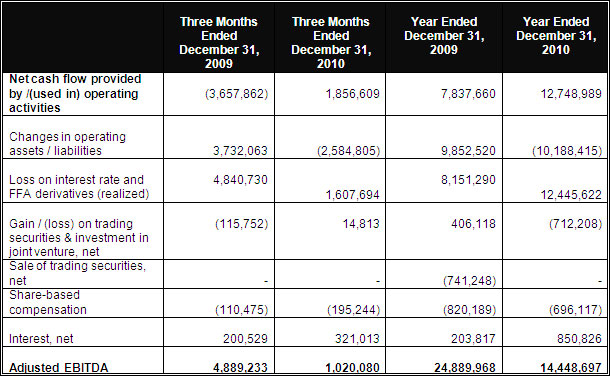
EBITDA Reconciliation:
Euroseas Ltd. considers Adjusted EBITDA to represent net earnings before interest, income taxes, depreciation, gain / loss in derivatives and amortization of deferred revenues from above or below market time charters acquired. Adjusted EBITDA does not represent and should not be considered as an alternative to net income or cash flow from operations, as determined by United States generally accepted accounting principles, or U.S. GAAP, and our calculation of Adjusted EBITDA may not be comparable to that reported by other companies. Adjusted EBITDA is included herein because it is a basis upon which we assess our financial performance and liquidity position and because we believe that it presents useful information to investors regarding a company's ability to service and/or incur indebtedness. The Company?s definition of Adjusted EBITDA may not be the same as that used by other companies in the shipping or other industries.
Reconciliation of Net Income / (loss) Excluding the Effect from Unrealized Loss / (Gain)
and Realized Loss on derivatives, Unrealized (Loss on trading securities and
Amortization of the Fair Value of Charters Acquired
to Net Loss
(All amounts expressed in U.S. Dollars - except share data and per share amounts)
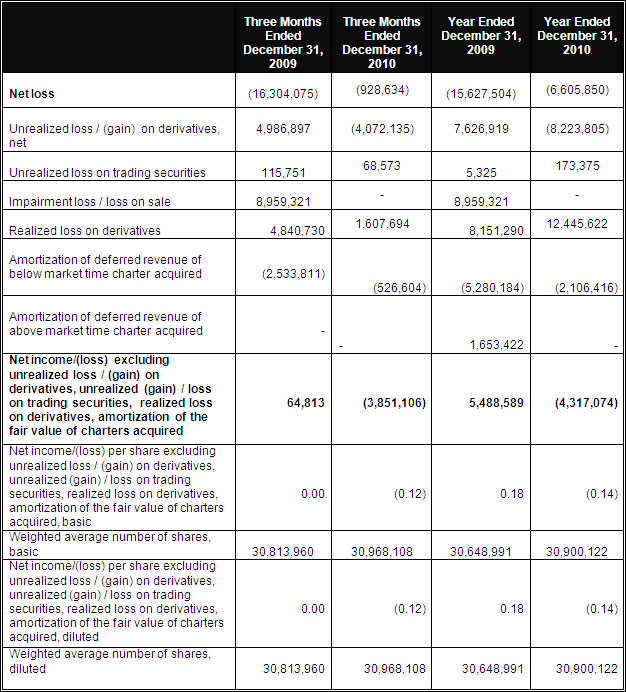
About Euroseas Ltd.
Euroseas Ltd. was formed on May 5, 2005 under the laws of the Republic of the Marshall Islands to consolidate the ship owning interests of the Pittas family of Athens, Greece, which has been in the shipping business over the past 136 years. Euroseas trades on the NASDAQ Global Market under the ticker ESEA since January 31, 2007.
Euroseas operates in the dry cargo, drybulk and container shipping markets. Euroseas' operations are managed by Eurobulk Ltd., an ISO 9001:2000 certified affiliated ship management company, which is responsible for the day-to-day commercial and technical management and operations of the vessels. Euroseas employs its vessels on spot and period charters and through pool arrangements.
The Company has a fleet of 16 vessels, including 4 Panamax drybulk carriers and 1 Handymax drybulk carrier, 3 Intermediate containership, 5 Handysize containerships, 2 Feeder containerships and a multipurpose dry cargo vessel. Euroseas` 5 drybulk carriers have a total cargo capacity of 331,808 dwt, its 10 containerships have a cargo capacity of 17,787 teu and its multipurpose vessel has a cargo capacity of 22,568 dwt or 950 teu.
Forward Looking Statement
This press release contains forward-looking statements (as defined in Section 27A of the Securities Act of 1933, as amended, and Section 21E of the Securities Exchange Act of 1934, as amended) concerning future events and the Company?s growth strategy and measures to implement such strategy; including expected vessel acquisitions and entering into further time charters. Words such as "expects," "intends," "plans," "believes," "anticipates," "hopes," "estimates," and variations of such words and similar expressions are intended to identify forward-looking statements. Although the Company believes that the expectations reflected in such forward-looking statements are reasonable, no assurance can be given that such expectations will prove to have been correct. These statements involve known and unknown risks and are based upon a number of assumptions and estimates that are inherently subject to significant uncertainties and contingencies, many of which are beyond the control of the Company. Actual results may differ materially from those expressed or implied by such forward-looking statements. Factors that could cause actual results to differ materially include, but are not limited to changes in the demand for dry bulk vessels and container ships, competitive factors in the market in which the Company operates; risks associated with operations outside the United States; and other factors listed from time to time in the Company?s filings with the Securities and Exchange Commission. The Company expressly disclaims any obligations or undertaking to release publicly any updates or revisions to any forward-looking statements contained herein to reflect any change in the Company?s expectations with respect thereto or any change in events, conditions or circumstances on which any statement is based. Visit our website www.euroseas.gr
Company Contact
Tasos Aslidis
Chief Financial Officer
Euroseas Ltd.
11 Canterbury Lane,
Watchung, NJ 07069
Tel. (908) 301-9091
E-mail: aha@euroseas.gr
Investor Relations / Financial Media
Nicolas Bornozis
President
Capital Link, Inc.
230 Park Avenue, Suite 1536
New York, NY 10169
Tel. (212) 661-7566
E-mail: nbornozis@capitallink.com
